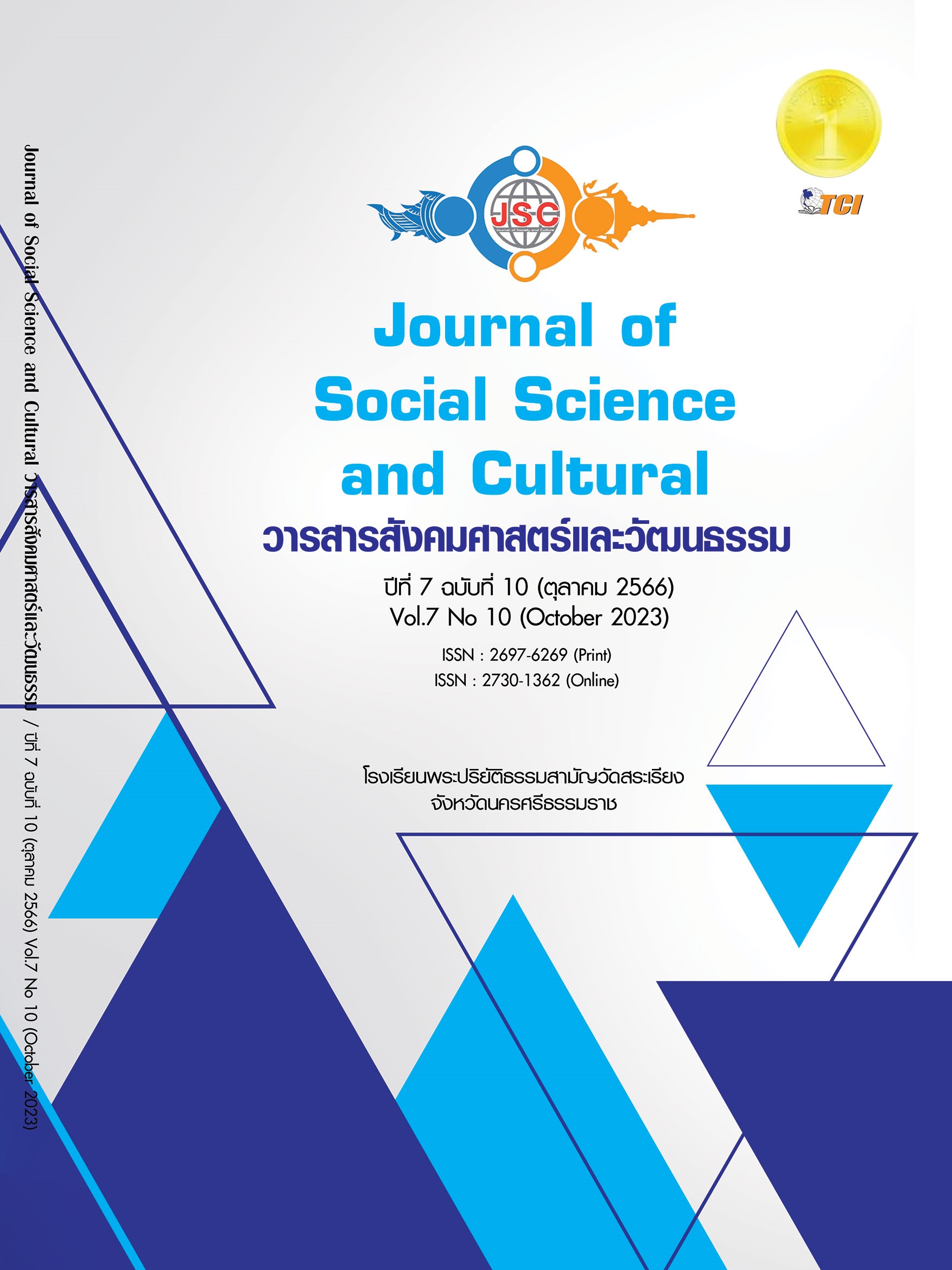หลักธรรมที่ปรากฏในตำนานประเพณีมาฆบูชาแห่ผ้าขึ้นธาตุนครศรีธรรมราช
Main Article Content
บทคัดย่อ
บทความวิชาการนี้ มีวัตถุประสงค์ 1) เพื่อศึกษาตำนานประเพณีมาฆบูชาแห่ผ้าขึ้นธาตุนครศรีธรรมราช 2) เพื่อวิเคราะห์หลักธรรมที่ปรากฏในตำนานประเพณีมาฆบูชาแห่ผ้าขึ้นธาตุนครศรีธรรมราช โดยวิธีการศึกษาค้นคว้าจากพระไตรปิฎก คัมภีร์ทางศาสนา ตำรา งานวิจัย วารสาร เว็บไซต์ และบทความวิชาการในรูปแบบต่าง ๆ แล้วนำมาวิเคราะห์ ผลการศึกษา พบว่า 1) ตามตำนานกล่าวไว้ว่า ในสมัยของพระเจ้าสามพี่น้อง คือ พระเจ้าจันทรภานุ พระเจ้าศรีธรรมาโศกราช และพระเจ้าพงษาสุระ ได้มีชาวพุทธกลุ่มหนึ่งเดินทางไปลังกา เพื่อจะนำผ้าพระบฏไปถวายเป็นพุทธบูชาพระทันตธาตุหรือพระเขี้ยวแก้วที่ลังกา และเข้ามาเมืองนครศรีธรรมราช เกิดเหตุเรือแตกกลางทะเล แล้วคลื่นได้ซัดผ้าพระบฏมาขึ้นที่ชายหาด ซึ่งขณะนั้นได้มีการเตรียมประกอบพิธีวิสาขะสมโภชพระบรมธาตุเจดีย์หลังจากที่พระองค์ได้บูรณะแล้วเสร็จ ซึ่งไม่กี่วันก่อนจะเริ่มพิธีชาวปากพนังได้เก็บผ้า “พระบฏ” ที่มีคลื่นซัดมาเกยชายหาด และประกาศหาเจ้าของจนได้ความว่า เป็นของชาวพุทธคณะหนึ่งที่เรือแตกกลางทะเล และยินดีถวายผ้าพระบฏให้ พระเจ้าศรีธรรมโศกราชจึงโปรดให้ชาวเมืองจัดเครื่องประโคมแห่แหนและนำขึ้นห่มโอบฐานพระบรมธาตุเจดีย์ พร้อมกับการสมโภชพระบรมธาตุเจดีย์ 2) จากการศึกษาหลักธรรม พบว่ามีหัวใจพระพุทธศาสนา คือ ไม่กล่าวร้ายผู้อื่น (อนูปวาโท) ไม่ทำร้ายผู้อื่น (อนูปฆาโต) และการสำรวมระวังในข้อปฏิบัติสำหรับตนเอง (ปาติโมกเข จ สังวโร) และความไม่ประมาทในการประกอบคุณงามความดีเพื่อยกระดับคุณภาพชีวิต
Article Details
เอกสารอ้างอิง
พระธรรมขันธ์. (2559). พระไตรปิฎก. เรียกใช้เมื่อ 2566 พฤษภาคม 28 จาก https://84000.org/
กองบรรณาธิการศิลปวัฒนธรรม. (2566). ประเพณีแห่ผ้าขึ้นธาตุ ตำนานเมืองนครฯ และเรื่องผ้าสีชมพูห่มพระมหาธาตุของรัชกาลที่ 5. เรียกใช้เมื่อ 2566 พฤษภาคม 9 จาก https://www.silpa-mag.com/
เทศบาลเมืองทุ่งสง. (2566). ประเพณีแห่ผ้าขึ้นธาตุ. เรียกใช้เมื่อ 2566 พฤษภาคม 9 จาก https://www. tungsong.com/
น้ำชุบ เว็บไซต์องค์ความรู้ศิลปะและวัฒนธรรมภาคใต้และคาบสมุทรสยาม-มลายู. (2566). แห่ผ้าขึ้นธาตุ. เรียกใช้เมื่อ 2566 พฤษภาคม 9 จาก https://www.naamchoop.com/know_id=63&know_name=แห่ผ้าขึ้นธาตุ
ปิ่น มุทุกันต์. (2531). มงคลชีวิต ภาค 3. กรุงเทพมหานคร: อมรการพิมพ์.
พระธรรมญาณมุณี. (2527). พระธรรมญาณมุณี 80 ปี. กรุงเทพมหานคร: อมรินทร์การพิมพ์.
พีพีทีวี. (2566). รู้จัก “แห่ผ้าขึ้นธาตุ” ประเพณีสำคัญของคนเมืองคอนคู่วันมาฆบูชา. เรียกใช้เมื่อ 2566 พฤษภาคม 9 จาก https://www.pptvhd36.com/news/
ไพฑูรย์ แก้วชูใส. (2555). รูปแบบการมีส่วนร่วมของพหุภาคีในการจัดการงานประเพณีแห่ผ้าขึ้นธาตุ จังหวัดนครศรีธรรมราช. ใน วิทยานิพนธ์ปรัชญาดุษฎีบัณฑิต สาขาวิชาการจัดการการท่องเที่ยวและการโรงแรม. มหาวิทยาลัยมหาสารคาม.
มหาจุฬาลงกรณราชวิทยาลัย. (2539). พระไตรปิฎกภาษาบาลี ฉบับมหาจุฬาลงกรณราชวิทยาลัย. กรุงเทพมหานคร: โรงพิมพ์จุฬาลงกรณวิทยาลัย.
มหาวิทยาลัยวลัยลักษณ์. (2566). ประเพณีแห่ผ้าขึ้นธาตุ วัดพระมหาธาตุวรมหาวิหาร นครศรีธรรมราช. เรียกใช้เมื่อ 2566 พฤษภาคม 9 จาก https://library.wu.ac.th/content/ประเพณีแห่ผ้าขึ้นธาตุ-ว/
มูลนิธิสารานุกรมวัฒนธรรมไทย ธนาคารไทยพานิช. (2542). สารานุกรมวัฒนธรรมไทย ภาคใต้ : หาบข้าว – เฮฮาสะหม้อ. กรุงเทพมหานคร: มูลนิธิสารานุกรมวัฒนธรรมไทย ธนาคารไทยพานิช.
ราชบัณฑิตยสถาน. (2552). พจนานุกรม ฉบับราชบัณฑิตยสถาน พ.ศ. 2554. กรุงเทพมหานคร: นานมีบุ๊คส์.
วิกิพีเดีย สารานุกรมเสรี. (2566). ประเพณีแห่ผ้าขึ้นธาตุ. เรียกใช้เมื่อ 2566 พฤษภาคม 28 จาก https://www. th.wikipedia.org/wiki/ประเพณีแห่ผ้าขึ้นธาตุ


